Related Research Articles

The greenhouse effect occurs when greenhouse gases in a planet's atmosphere cause some of the heat radiated from the planet's surface to build up at the planet's surface. This process happens because stars emit shortwave radiation that passes through greenhouse gases, but planets emit longwave radiation that is partly absorbed by greenhouse gases. That difference reduces the rate at which a planet can cool off in response to being warmed by its host star. Adding to greenhouse gases further reduces the rate a planet emits radiation to space, raising its average surface temperature.
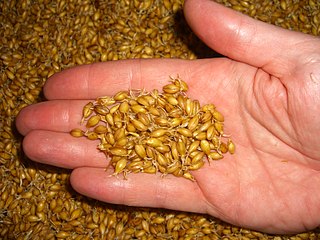
Malt is a cereal grain that has been made to germinate by soaking in water and is then halted from germinating further by drying with hot air, a process known as "malting". Malted grain is used to make beer, whisky, malted milk, malt vinegar, confections such as Maltesers and Whoppers, flavored drinks such as Horlicks, Ovaltine, and Milo, and some baked goods, such as malt loaf, bagels, and Rich Tea biscuits. Malted grain that has been ground into a coarse meal is known as "sweet meal".

Flour is a powder made by grinding raw grains, roots, beans, nuts, or seeds. Flours are used to make many different foods. Cereal flour, particularly wheat flour, is the main ingredient of bread, which is a staple food for many cultures. Corn flour has been important in Mesoamerican cuisine since ancient times and remains a staple in the Americas. Rye flour is a constituent of bread in both Central Europe and Northern Europe.
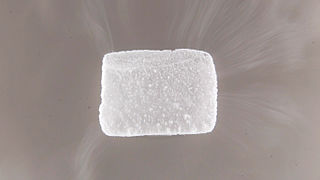
Dry ice is the solid form of carbon dioxide. It is commonly used for temporary refrigeration as CO2 does not have a liquid state at normal atmospheric pressure and sublimates directly from the solid state to the gas state. It is used primarily as a cooling agent, but is also used in fog machines at theatres for dramatic effects. Its advantages include lower temperature than that of water ice and not leaving any residue (other than incidental frost from moisture in the atmosphere). It is useful for preserving frozen foods (such as ice cream) where mechanical cooling is unavailable.

Water vapor, water vapour or aqueous vapor is the gaseous phase of water. It is one state of water within the hydrosphere. Water vapor can be produced from the evaporation or boiling of liquid water or from the sublimation of ice. Water vapor is transparent, like most constituents of the atmosphere. Under typical atmospheric conditions, water vapor is continuously generated by evaporation and removed by condensation. It is less dense than most of the other constituents of air and triggers convection currents that can lead to clouds and fog.

The atmosphere of Earth is the layer of gases, known collectively as air, retained by Earth's gravity that surrounds the planet and forms its planetary atmosphere. The atmosphere of Earth creates pressure, absorbs most meteoroids and ultraviolet solar radiation, warms the surface through heat retention, allowing life and liquid water to exist on the Earth's surface, and reduces temperature extremes between day and night.

Steeping is the soaking of an organic solid, such as leaves, in a liquid to extract flavours or to soften it. The specific process of teas being prepared for drinking by leaving the leaves in heated water to release the flavour and nutrients is known as steeping. Herbal teas may be prepared by decoction, infusion, or maceration. Some solids are soaked to remove an ingredient, such as salt, where the solute is not the desired product.

Nixtamalization is a process for the preparation of maize, or other grain, in which the grain is soaked and cooked in an alkaline solution, usually limewater, washed, and then hulled. The term can also refer to the removal via an alkali process of the pericarp from other grains such as sorghum.
A building envelope or building enclosure is the physical separator between the conditioned and unconditioned environment of a building, including the resistance to air, water, heat, light, and noise transfer.
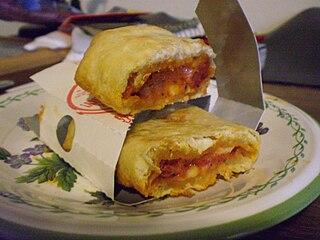
A susceptor is a material used for its ability to absorb electromagnetic energy and convert it to heat. The electromagnetic energy is typically radiofrequency or microwave radiation used in industrial heating processes, and also in microwave cooking.
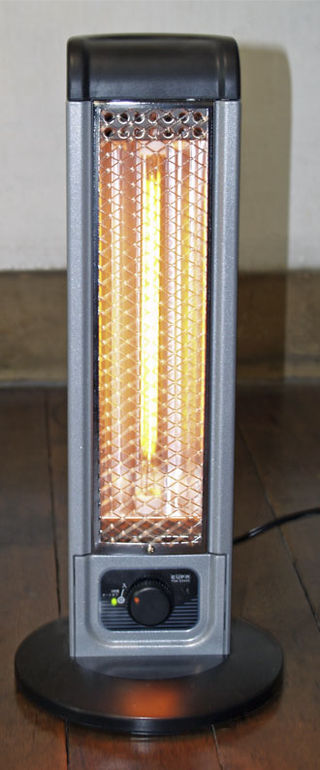
An infrared heater or heat lamp is a heating appliance containing a high-temperature emitter that transfers energy to a cooler object through electromagnetic radiation. Depending on the temperature of the emitter, the wavelength of the peak of the infrared radiation ranges from 750 nm to 1 mm. No contact or medium between the emitter and cool object is needed for the energy transfer. Infrared heaters can be operated in vacuum or atmosphere.

Intensive crop farming is a modern industrialized form of crop farming. Intensive crop farming's methods include innovation in agricultural machinery, farming methods, genetic engineering technology, techniques for achieving economies of scale in production, the creation of new markets for consumption, patent protection of genetic information, and global trade. These methods are widespread in developed nations.

Greenhouse gases are the gases in the atmosphere that raise the surface temperature of planets such as the Earth. What distinguishes them from other gases is that they absorb the wavelengths of radiation that a planet emits, resulting in the greenhouse effect. The Earth is warmed by sunlight, causing its surface to radiate heat, which is then mostly absorbed by water vapor (H2O), carbon dioxide (CO2), methane (CH4), nitrous oxide (N2O), and ozone (O3). Without greenhouse gases, the average temperature of Earth's surface would be about −18 °C (0 °F), rather than the present average of 15 °C (59 °F).

A walnut is the edible seed of any tree of the genus Juglans, particularly the Persian or English walnut, Juglans regia. The fruits of trees in the family Juglandaceae are often confused with drupes. Still, they are accessory fruit because the outer covering of the fruit is technically an involucre and thus not morphologically part of the carpel; this means it cannot be a drupe but is instead a drupe-like nut.

Malting is the process of steeping, germinating and drying grain to convert it into malt. Germination and sprouting involve a number of enzymes to produce the changes from seed to seedling and the malt producer stops this stage of the process when the required enzymes are optimal. Among other things, the enzymes convert starch to sugars such as maltose, maltotriose and maltodextrines, hence the name malt.

Edward Purdy Ney was an American physicist who made major contributions to cosmic ray research, atmospheric physics, heliophysics, and infrared astronomy. He was a discoverer of cosmic ray heavy nuclei and of solar proton events. He pioneered the use of high-altitude balloons for scientific investigations and helped to develop procedures and equipment that underlie modern scientific ballooning. He was one of the first researchers to put experiments aboard spacecraft.
Grain damage is any degradation in the quality of grain. In the current grain trade, this damage can affect price, feed quality, food product quality, and susceptibility to pest contamination. Between the field and the end use, grain may go through any number of handling operations which can each contribute to grain damage. For example, grain might encounter free fall, conveyors, spouts, grain throwers, elevators, hoppers, dryers, and many more. Overall, these handling methods can be evaluated as to what effect they have on the grain. Damaged grain can often be characterized by the extent to which it reduces storage time. For example, cracked or broken kernels are more susceptible to insect or bacteria as well as chemical degradation. The damage to the actual grain is only one example of losses incurred after harvest. In order to quantify grain damage, one must also understand grain quality. Grain quality is a very broad term and can relate to many topics such as foreign material, chemical compositions, mechanical damage, insect infestations, and many more. These references to quality are highly dependent on the end use of the grain. Certain types of damage may be acceptable to specific industries, whereas others cannot use grain with these issues.
Grain drying is process of drying grain to prevent spoilage during storage. The grain drying described in this article is that which uses fuel- or electric-powered processes supplementary to natural ones, including swathing/windrowing for drying by ambient air and sunshine, or stooking before threshing.
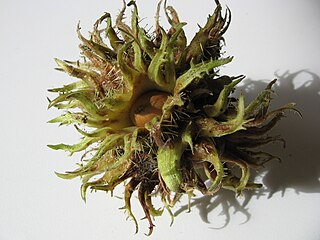
Husk in botany is the outer shell or coating of a seed. In the United States, the term husk often refers to the leafy outer covering of an ear of maize (corn) as it grows on the plant. Literally, a husk or hull includes the protective outer covering of a seed, fruit, or vegetable.

Corn wet-milling is a process of breaking corn kernels into their component parts: corn oil, protein, corn starch, and fiber. It uses water and a series of steps to separate the parts to be used for various products.
References
- "Natural-air drying of shelled corn catches on despite mixed reviews..." Lancaster Farming . Penn State University, ActivePaper Archive. February 10, 1979. Archived from the original on March 3, 2016. Retrieved 2009-08-14.